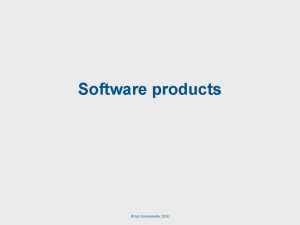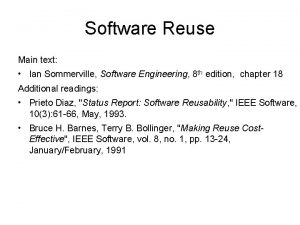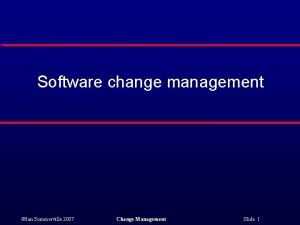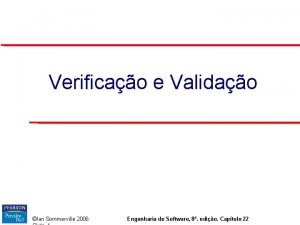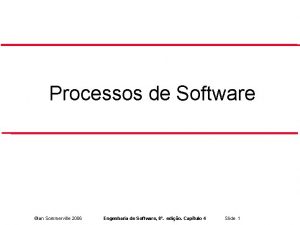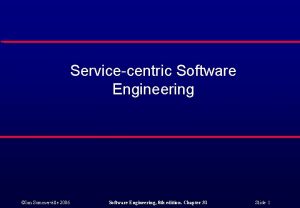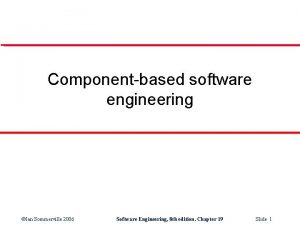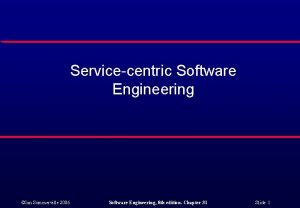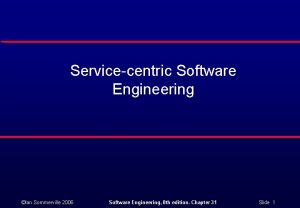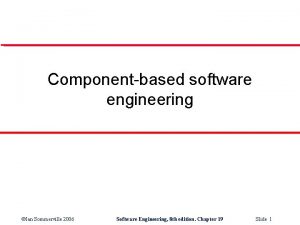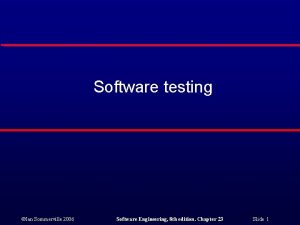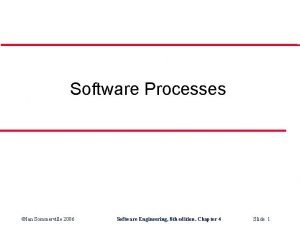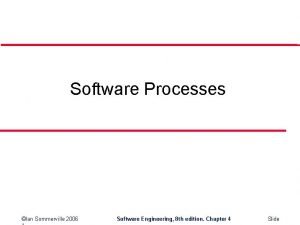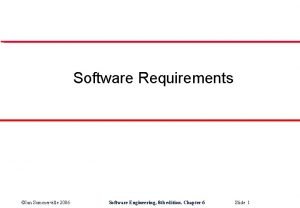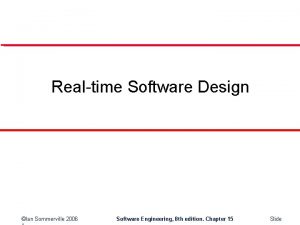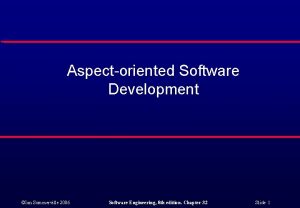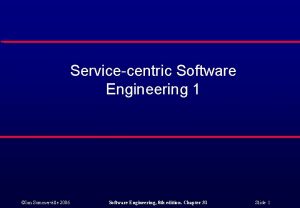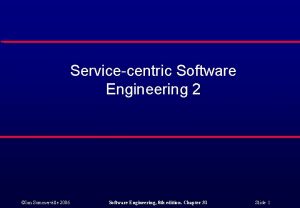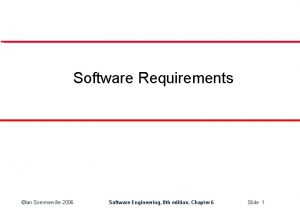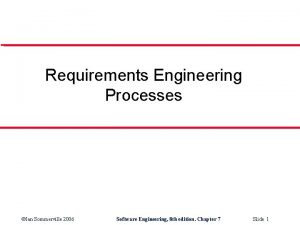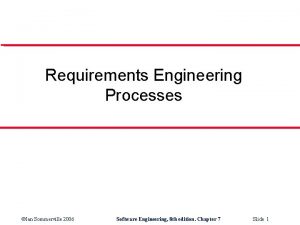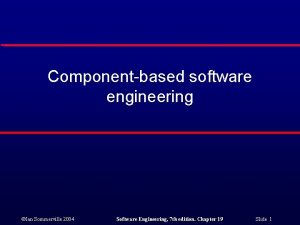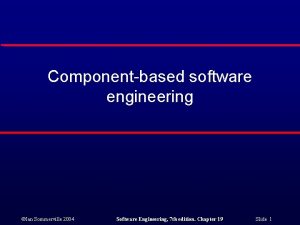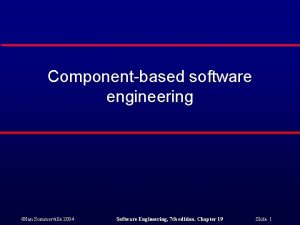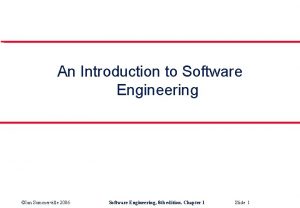Security Engineering Ian Sommerville 2006 Software Engineering 8






































- Slides: 38

Security Engineering ©Ian Sommerville 2006 Software Engineering, 8 th edition. Chapter 30 Slide 1

Objectives l l To introduce issues that must be considered in the specification and design of secure software To discuss security risk management and the derivation of security requirements from a risk analysis To describe good design practice for secure systems development. To explain the notion of system survivability and to introduce a method of survivability analysis. ©Ian Sommerville 2006 Software Engineering, 8 th edition. Chapter 30 Slide 2

Topics covered l l Security concepts Security risk management Design for security System survivability ©Ian Sommerville 2006 Software Engineering, 8 th edition. Chapter 30 Slide 3

Security engineering l l Tools, techniques and methods to support the development and maintenance of systems that can resist malicious attacks that are intended to damage a computer-based system or its data. A sub-field of the broader field of computer security. ©Ian Sommerville 2006 Software Engineering, 8 th edition. Chapter 30 Slide 4

System layers ©Ian Sommerville 2006 Software Engineering, 8 th edition. Chapter 30 Slide 5

Application/infrastructure security l l l Application security is a software engineering problem where the system is designed to resist attacks. Infrastructure security is a systems management problem where the infrastructure is configured to resist attacks. The focus of this chapter is application security. ©Ian Sommerville 2006 Software Engineering, 8 th edition. Chapter 30 Slide 6

Security concepts ©Ian Sommerville 2006 Software Engineering, 8 th edition. Chapter 30 Slide 7

Examples of security concepts ©Ian Sommerville 2006 Software Engineering, 8 th edition. Chapter 30 Slide 8

Security threats l l l Threats to the confidentiality of a system or its data Threats to the integrity of a system or its data Threats to the availability of a system or its data ©Ian Sommerville 2006 Software Engineering, 8 th edition. Chapter 30 Slide 9

Security controls l l l Controls that are intended to ensure that attacks are unsuccessful. This is analagous to fault avoidance. Controls that are intended to detect and repel attacks. This is analagous to fault detection and tolerance. Controls that are intended to support recovery from problems. This is analagous to fault recovery. ©Ian Sommerville 2006 Software Engineering, 8 th edition. Chapter 30 Slide 10

Security risk management l l l Risk management is concerned with assessing the possible losses that might ensue from attacks on the system and balancing these losses against the costs of security procedures that may reduce these losses. Risk management should be driven by an organisational security policy. Risk management involves • • Preliminary risk assessment Life cycle risk assessment ©Ian Sommerville 2006 Software Engineering, 8 th edition. Chapter 30 Slide 11

Preliminary risk assessment ©Ian Sommerville 2006 Software Engineering, 8 th edition. Chapter 30 Slide 12

Asset analysis ©Ian Sommerville 2006 Software Engineering, 8 th edition. Chapter 30 Slide 13

Threat and control analysis ©Ian Sommerville 2006 Software Engineering, 8 th edition. Chapter 30 Slide 14

Security requirements l l l Patient information must be downloaded at the start of a clinic session to a secure area on the system client that is used by clinical staff. Patient information must not be maintained on system clients after a clinic session has finished. A log on a separate computer from the database server must be maintained of all changes made to the system database. ©Ian Sommerville 2006 Software Engineering, 8 th edition. Chapter 30 Slide 15

Life cycle risk assessment l l l Risk assessment while the system is being developed and after it has been deployed More information is available - system platform, middleware and the system architecture and data organisation. Vulnerabilities that arise from design choices may therefore be identified. ©Ian Sommerville 2006 Software Engineering, 8 th edition. Chapter 30 Slide 16

Examples of design decisions l l l System users authenticated using a name/password combination. The system architecture is client-server with clients accessing the system through a standard web browser. Information is presented as an editable web form. ©Ian Sommerville 2006 Software Engineering, 8 th edition. Chapter 30 Slide 17

Technology vulnerabilities ©Ian Sommerville 2006 Software Engineering, 8 th edition. Chapter 30 Slide 18

Design for security l l l Architectural design - how do architectural design decisions affect the security of a system? Good practice - what is accepted good practice when designing secure systems? Design for deployment - what support should be designed into a system to avoid the introduction of vulnerabilities when a system is deployed for use? ©Ian Sommerville 2006 Software Engineering, 8 th edition. Chapter 30 Slide 19

Architectural design l Protection • l Distribution • l How should the system be organised so that critical assets can be protected against external attack? How should system assets be distributed so that the effects of a successful attack are minimised? Potentially conflicting • If assets are distributed, then they are more expensive to protect. ©Ian Sommerville 2006 Software Engineering, 8 th edition. Chapter 30 Slide 20

Protection l l l Platform-level protection Application-level protection Record-level protection ©Ian Sommerville 2006 Software Engineering, 8 th edition. Chapter 30 Slide 21

Layered protection ©Ian Sommerville 2006 Software Engineering, 8 th edition. Chapter 30 Slide 22

A distributed equity system ©Ian Sommerville 2006 Software Engineering, 8 th edition. Chapter 30 Slide 23

Design guidelines l l Design guidelines encapsulate good practice in secure systems design Design guidelines serve two purposes: • • They raise awareness of security issues in a software engineering team. They can be used as the basis of a review checklist that is applied during the system validation process. ©Ian Sommerville 2006 Software Engineering, 8 th edition. Chapter 30 Slide 24

Design guidelines 1 l l l Base security decisions on an explicit security policy Avoid a single point of failure Fail securely Balance security and usability Be aware of the possibilities of social engineering ©Ian Sommerville 2006 Software Engineering, 8 th edition. Chapter 30 Slide 25

Design guidelines 2 l l l Use redundancy and diversity to reduce risk Validate all inputs Compartmentalise your assets Design for deployment Design for recoverability ©Ian Sommerville 2006 Software Engineering, 8 th edition. Chapter 30 Slide 26

Design for deployment l l l Deployment involves configuring software to operate in its working environment, installing the system and configuring it for the operational platform. Vulnerabilities may be introduced at this stage as a result of configuration mistakes. Designing deployment support into the system can reduce the probability that vulnerabilities will be introduced. ©Ian Sommerville 2006 Software Engineering, 8 th edition. Chapter 30 Slide 27

System deployment ©Ian Sommerville 2006 Software Engineering, 8 th edition. Chapter 30 Slide 28

Deployment support l l Include support for viewing and analysing configurations Minimise default privileges and thus limit the damage that might be caused Localise configuration settings Provide easy ways to fix security vulnerabilities ©Ian Sommerville 2006 Software Engineering, 8 th edition. Chapter 30 Slide 29

System survivability l l Survivability is an emergent system property that reflects the systems ability to deliver essential services whilst it is under attack or after part of the system has been damaged Survivability analysis and design should be part of the security engineering process ©Ian Sommerville 2006 Software Engineering, 8 th edition. Chapter 30 Slide 30

Service availability l l l Which system services are the most critical for a business? How might these services be compromised? What is the minimal quality of service that must be maintained? How can these services be protected? If a service becomes unavailable, how quickly can it be recovered? ©Ian Sommerville 2006 Software Engineering, 8 th edition. Chapter 30 Slide 31

Survivability strategies l Resistance • l Recognition • l Avoiding problems by building capabilities into the system to resist attacks Detecting problems by building capabilities into the system to detect attacks and failures and assess the resultant damage Recovery • Tolerating problems by building capabilities into the system to deliver services whilst under attack ©Ian Sommerville 2006 Software Engineering, 8 th edition. Chapter 30 Slide 32

System survivability method ©Ian Sommerville 2006 Software Engineering, 8 th edition. Chapter 30 Slide 33

Key activities l System understanding • l Critical service identification • l Identify services that must be maintained Attack simulation • l Review golas, requirements and architecture Devise attack scenarios and identify components affected Survivability analysis • Identify survivability strategies to be applied ©Ian Sommerville 2006 Software Engineering, 8 th edition. Chapter 30 Slide 34

Trading system survivability l l l User accounts and equity prices replicated across servers so some provision for survivability made Key capability to be maintained is the ability to place orders for stock Orders must be accurate and reflect the actual sales/purchases made by a trader ©Ian Sommerville 2006 Software Engineering, 8 th edition. Chapter 30 Slide 35

Survivability analysis ©Ian Sommerville 2006 Software Engineering, 8 th edition. Chapter 30 Slide 36

Key points l l Security engineering is concerned with how to develop systems that can resist malicious attacks Security threats can be threats to confidentiality, integrity or availability of a system or its data Security risk management is concerned with assessing possible losses from attacks and deriving security requirements to minimise losses Design for security involves architectural design, following good design practice and minimising the introduction of system vulnerabilities ©Ian Sommerville 2006 Software Engineering, 8 th edition. Chapter 30 Slide 37

Key points l l Key issues when designing a secure architecture include organising the structure to protect assets and distributing assets to minimise losses General security guidelines sensitise designers to security issues and serve as review checklists Configuration visualisation, setting localisation, and minimisation of default privileges help reduce deployment errors System survivability reflects the ability of a system to deliver services whilst under attack or after part of the system has been damaged. ©Ian Sommerville 2006 Software Engineering, 8 th edition. Chapter 30 Slide 38
 Engineering software products ian sommerville
Engineering software products ian sommerville Simple aspect example
Simple aspect example Inżynieria oprogramowania ian sommerville
Inżynieria oprogramowania ian sommerville Sommerville software engineering slides
Sommerville software engineering slides Private secruity
Private secruity Sommerville 2007
Sommerville 2007 Sommerville
Sommerville Sommerville
Sommerville Sommerville
Sommerville Uml 2 uma abordagem prática
Uml 2 uma abordagem prática Sommerville
Sommerville Sommerville
Sommerville Sommerville
Sommerville Elaine sommerville
Elaine sommerville 666 rule powerpoint
666 rule powerpoint Building security software
Building security software Software maintenance in software engineering ppt
Software maintenance in software engineering ppt What is software implementation in software engineering
What is software implementation in software engineering What is software metrics in software engineering
What is software metrics in software engineering Example of software crisis
Example of software crisis Software measurement and metrics in software engineering
Software measurement and metrics in software engineering Real time software design in software engineering
Real time software design in software engineering Design principles in software engineering
Design principles in software engineering What is system in software engineering
What is system in software engineering Forward engineering and reverse engineering
Forward engineering and reverse engineering What is the osi security architecture
What is the osi security architecture Guide to network security
Guide to network security Wireless security in cryptography and network security
Wireless security in cryptography and network security Explain about visa international security mode
Explain about visa international security mode Electronic mail security in network security
Electronic mail security in network security Information security
Information security E commerce security meaning
E commerce security meaning Security guide to network security fundamentals
Security guide to network security fundamentals Security guide to network security fundamentals
Security guide to network security fundamentals Ian milborrow pwc
Ian milborrow pwc Ian juliano
Ian juliano Cloud ral
Cloud ral Calptotectin
Calptotectin Ian scott international
Ian scott international
